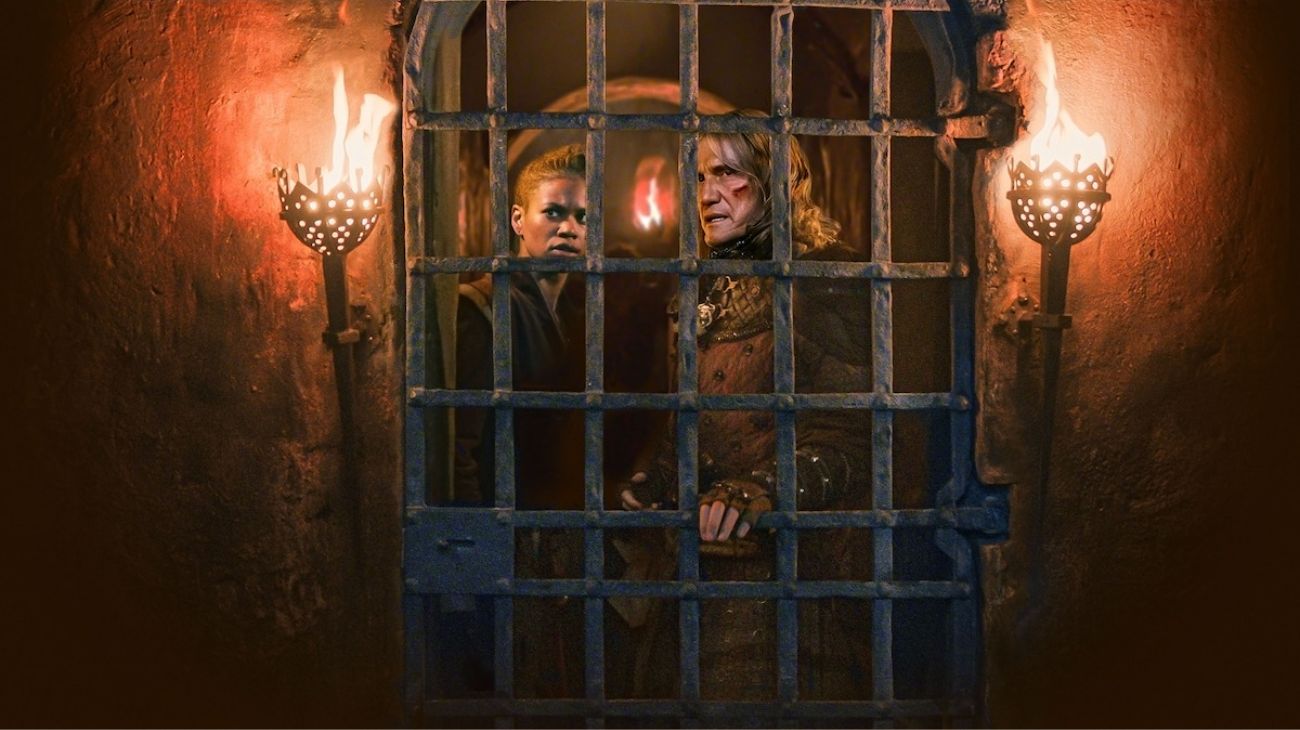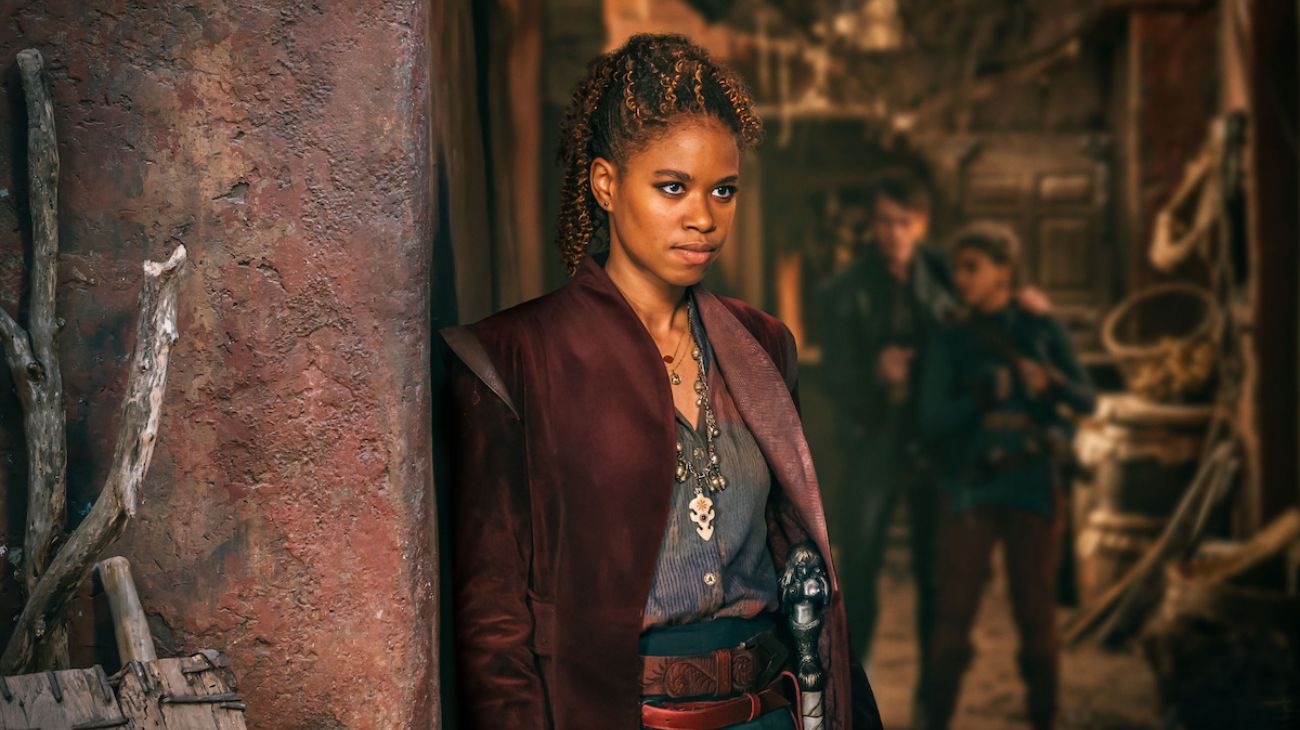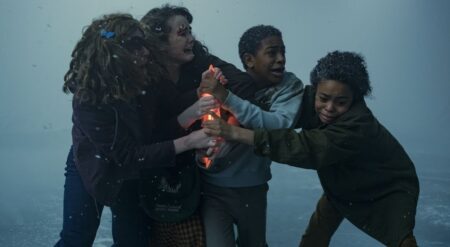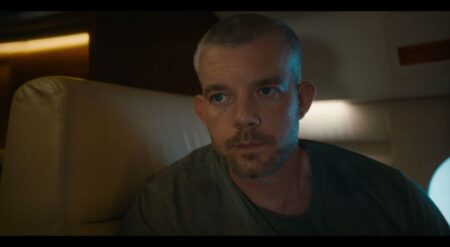Netflix rarely shadow drops its entertainment nowadays, so when it does, well, it honestly feels like a little treat. The Rats: A Witcher’s Tale focuses on the titular gang of young thieves before they become Ciri’s (Freya Allan) surrogate family in The Witcher Season 4.
Pulled together by their need to survive and after having suffered significant trauma, the Rats are a large part of Ciri’s character arc, or rather, their death is. The special episode takes audiences through their formation and why Leo Bonhart (Sharlto Copley), the bounty hunter who murders and mutilates them in the Season 4 finale, was hunting them and met them with such brutality.
Now, that isn’t a spoiler. The Rats: A Witcher’s Tale begins with Ciri tied up, leaning against a barrel that holds the pickled heads of the people she had begun to see as family, and the girl she was starting to love. Bonhart, driving the cart, begins to tell Ciri their story, before the perspective shifts to the past, between Season 3 and Season 4, where the gang was formed.
The Rats: A Witcher’s Tale offers much-needed context to the emotional weight of The Witcher Season 4’s finale.
Taking place around one big job after the group had already formed, The Rats: A Witcher’s Tale looks at the class divides in the Continent and what a washed-up Witcher can even do. But at its core, it’s a heist episode, and in that respect, it’s better for it.
The special’s primary plot links the Rats to Dominik Houvenaghel. He has opened a brutal fighting arena, and the Rats are there to take Houvenaghel’s treasure. Each Rat plays into a different heist archetype, and seeing how the roles have been adapted to a fantasy setting is well done. Then, everything goes wrong, and the consequences begin to stack up.
In addition to being a heist story, it’s also one that aims to provide necessary context for the gang, who are often dismissed as hooligans at best and villains at worst, depending on the job they are doing. More importantly, however, it also highlights what the youth on the Continent are living through and what they’re becoming.
While I won’t get into everyone’s backstory (as the special episode does), the vital thing to understand about each Rat is that they have suffered a significant traumatic experience tied to Emhyr’s (Bart Edwards) siege. They have only survived because they are working together, and because they have set the world to change them. The characters at the core of the special episode are Mistle (Christelle Elwin), Asse (Connor Crawford), Giselher (Ben Radcliffe), Iskra (Aggy K. Adams), Kayleigh (Fabian McCallum), and Reef (Juliette Alexandra). However, Mistle takes up the bulk of the screen time.
The Rats: A Witcher’s Tale captures the burden of youth in the Continent.

Mistle’s backstory provides important context for why she meets Ciri with such understanding and love, even before they begin their relationship. Mistle is highborn, having only lost her status when she fled Emhyr’s attack after her family was murdered. Despite leaving with Asse, Mistle still feels a deep loneliness, having also lost her lover, a handmaiden named Juniper (Deoudoné van der Merwe), in the attack as well.
But Juniper’s memory eats into Mistle’s everyday life. She survived because she was able to escape the mercenary named Bert Brigden (Ben Robson), but in the process, she left Juniper behind. Mistle’s story takes up a lot of the spotlight in The Rats: A Witcher’s Tale. Still, it makes sense. She mirrors Ciri’s story.
Mistle is alone, traumatized, and carrying with her a fear awakened from realizing how violent and hostile the world around her is. She went from being a protected highborn girl to having to survive. Mistle struggled to trust and stop carrying guilt over something she could not control, and it’s destroying her.
While the character we see at the end of the special is who we know in Season 4, learning about her return to believing in tenderness in the world after facing so much pain brings a gravitas to both her romance with Ciri and her death.
Mistle is given a significant amount of depth in The Rats: A Witcher’s Tale, with Christelle Elwin delivering an empathetic performance.

The Rats: A Witcher’s Tale is sorely missed from The Witcher Season 4. While the transformation and traumatic coming-of-age that Ciri went through were powerful, one of the key issues in the primary season that the show struggled with was the lack of depth given to the wider ensemble casts. Why introduce new groups and relationships and just make them fodder? In fact, outside of Mistle’s death at the end of Season 4, I felt nothing when the other Rats were murdered.
With so much going on in any given story point, the larger casts surrounding our heroes faded into the background, yet they were still expected to carry emotional weight. By adding The Rats: A Witcher’s Tale into the mix, Ciri’s development in the season and her newfound family mean so much more.
We see who they are, we understand them, and it turns them from a group of rowdy young adults who, quite frankly, don’t even seem to have a moral compass that isn’t pointing toward gold, into a group with badly needed depth.
By letting The Rats: A Witcher’s Tale play next when I finished The Witcher Season 4, I learned more about the characters that felt as disposable as their deaths made them seem in the larger scope of the continent. It took them from bodies brought in to make Ciri suffer when they die, to characters with relationships, wants, and pasts.
Dolph Lundgren’s Brehen is easily the best part of The Rats: A Witcher’s Tale.

Still, while the titular subjects of this 60-minute watch get their due, it’s Dolph Lundgren’s Brehen, a Witcher from the Cat School, that steals the show. A cantankerous drunk, Brehen is a washed-up Witcher who finds no value in the world anymore.
But, he’s also the only hope that the Rats have to pull off the heist and all survive it. After recruiting Brehen for the job, he helps them understand their limitations and their strengths as he teaches them how to fight and win, and when to run.
His sincerity in his sadness comes through beautifully and continues Netflix’s focus in Season 4, which is that the Witchers are not emotionless, no matter how much they were made to be by the trials they went through. Instead, they love, they feel, and more importantly, they can fail miserably.
While Lundgren’s line delivery did leave something missing in some scenes, once the third act of this prequel episode began, he came into his own. Once he was more than just a washed-up Witcher and became a mentor, that’s when he came alive in the role. And while some of that may be by narrative design, the drastic difference in acting quality between the two ways we see the character sticks out.
The Rats A Witcher’s Tale wears its heart on its sleeve, and the larger use of practical effects makes this special stand out. The only sin that this special carries is that it belongs in the primary Season 4. It’s deeply connected to a season you have to watch to appreciate, and yet, it’s an optional viewing for audiences of the series.
The Rats: A Witcher’s Tale is a testament to why we need longer seasons, which prestige television series and streamers have generally abandoned. It fits neatly with Season 4, to the point where it enhances the series and provides an integral part of Netflix’s Witcher canon to understand. The Rats: A Witcher’s Tale may take a little to gain steam, but its importance can’t be understated for those who have stuck with the Witcherverse on Netflix.
The Rats: A Witcher’s Tale is streaming now, exclusively on Netflix.
Season 1 | Season 2 | Season 3 Pt. 1 | Season 3 Pt. 2 | Blood Origins
The Rats: A Witcher's Tale
-
Rating - 7/107/10
TL;DR
The Rats: A Witcher’s Tale is a testament to why we need longer seasons, which prestige television series and streamers have generally abandoned.









